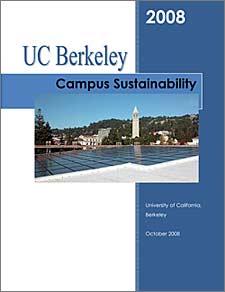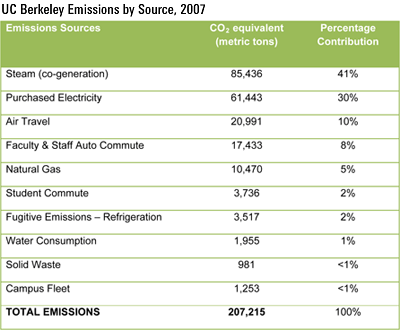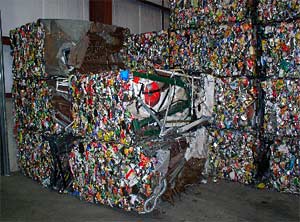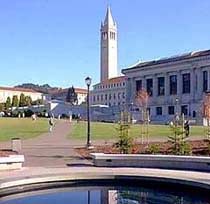Sustainability: A progress report
Berkeley demonstrates green leadership not just in the UC system but among universities nationwide
| 11 December 2008
 BERKELEY — Stepped-up recycling, lighting retrofits, increased transit use, habitat restoration along Strawberry Creek, and more local and organic food in the dining halls are just a few of the ways Berkeley is making progress toward meeting its ambitious sustainability goals.
BERKELEY — Stepped-up recycling, lighting retrofits, increased transit use, habitat restoration along Strawberry Creek, and more local and organic food in the dining halls are just a few of the ways Berkeley is making progress toward meeting its ambitious sustainability goals.
The many advances toward a greener Berkeley — along with partial successes and initiatives yet to be tackled — are laid out in the 2008 sustainability assessment issued this fall by the Office of Sustainability and the Chancellor's Advisory Committee on Sustainability (CACS).
For the first time, the report measures advances made, checking on progress toward 78 goals identified on the basis of the last such assessment, done in 2005. Of the total, more than half were completed, and another 30 percent are well under way.
"More important, the 2008 assessment is the start of annual reporting on these kinds of issues," says Lisa McNeilly, director of sustainability for Berkeley.
Chancellor Robert Birgeneau has made the greening of Berkeley one of his top priorities, and brought McNeilly in almost a year ago to oversee the multifaceted campus effort to cut its greenhouse-gas emissions and reduce its carbon footprint. Initiatives are moving forward on nine fronts: water and energy use, waste reduction, green building, transportation, land use, purchasing, and food, as well as in-classroom academic endeavors related to the environment.
In addition, the principle of sustainability has been woven into broader policies and plans, the assessment points out.
"A lot of people have put a lot of energy into these projects, and it was time to sit down and say we did a lot in the last three years," McNeilly says. "And by 'we,' I mean the campus."
 Source: 2008 Campus Sustainability Assessment
Source: 2008 Campus Sustainability AssessmentAmong the major milestones achieved since 2005, McNeilly points to the completion of an inventory of the campus's greenhouse-gas emissions, the Climate Action Feasibility Study, and the adoption of the Cal Climate Action Partnership (CalCAP) goal of reducing emissions to 1990 levels by 2014, six years ahead of the state's mandated target.
At the UC Office of the President, sustainability manager Matt StClair says Berkeley has been a leader both in the UC system and among universities nationwide when it comes to sustainability.
"Berkeley was the first to do an assessment in 2005, and now several other campuses have done their own. They charted the path there," StClair says.
The campus was also one of the first universities in the country to adopt a climate plan, one that's now serving as a model for other universities, he adds.
A major part of the 2008 assessment involved creating a snapshot of what kinds of energy are being used where on campus, and tracking those numbers back to 1990 as a way of charting trends. That meant setting baselines, benchmarks, and other quantitative measures of Berkeley's performance in scores of areas.
Reporting the numbers opens up conversations that will build paths to improvement, and creates a transparency that's essential to the sustainability efforts, McNeilly says, adding:
"You don't manage what you don't measure, to quote the old adage."
Among the assessment's major findings:
Energy and climate
Recent efforts have kept rampaging power use in check despite the arrival of thousands of computers and more air conditioning on campus since 1990.
Electricity use, one of the campus's top emissions generators, has risen three times faster than the campus population since 1990. But since 2005, that trend has slowed almost to a stop, and electricity use has inched up just 1 percent, thanks to an aggressive campaign to retrofit old lighting fixtures and install more LED lights. Retrofits in 30 buildings have saved 572,155 kilowatt-hours a year, according to the report.
Berkeley also is finalizing its Strategic Energy Plan (SEP), which is expected to reduce emissions by up to 40 percent, the assessment says.
Transportation
Buses and BART have replaced solo car commutes for a chunk of faculty and staff, so the "drive-alone" rate has dropped from 60 percent in 1990 to 47 percent in 2006, the most recent year for which numbers were available.
Transit use stands at one-quarter for faculty and staff, and almost a third for students — both numbers up considerably over 1990 levels.
While the current campus goal is to reduce the drive-alone rate, McNeilly says that getting this data down on paper allows planners to move to the next step, collecting information on fuel efficiency and miles driven with an eye toward the ultimate goal: coming up with ways to reduce the fuel used in commuting.
Nailing down the numbers can both raise consciousness about the issue and stimulate discussion of solutions, according to McNeilly.
"If you can report on multiple aspects of a particular issue, it really helps drive progress," she says.
Waste
By adding in the recycling of metal, concrete, and other debris from construction projects, Berkeley succeeded in keeping more than half its solid waste from ending up in landfills, hitting 57 percent last year, up from an estimated 21 percent in 1990 and well over the systemwide goal of 50 percent.
 Composting is up nearly 50 percent since 2005, and 100 percent since 2000.
Composting is up nearly 50 percent since 2005, and 100 percent since 2000.
Efforts also have been made to avoid creating waste in the first place, with programs to encourage two-sided printing and substituting reusable mugs and water bottles for paper or plastic.
When it comes to mixed paper, though, the assessment says "a significant amount" is still not being recycled.
"The reason the [overall waste diversion]number is so high for '07 is in part due to the demolition of Warren Hall, where we achieved well over a 95 percent recycling rate," McNeilly points out. "We may not achieve the same rate next year if we don't demolish a building."
She adds, "Sharing the nuances of what is, and what is not, part of the outcomes is an important goal for me."
Purchasing
UCOP is leading efforts on all 10 campuses to establish purchasing preferences for products that have smaller environmental impacts over their lifetime, from EnergyStar appliances to copy paper made from recycled paper. Berkeley has introduced Sustainable Copy Paper Guidelines, and cut its use of non-recycled-content copy paper from 70 percent to 35 percent of the total.
Janitorial supplies are going green too, with half of all purchases in 2007 falling into that classification.
Food and dining
 This area completed nine of its 10 goals, and by 2008 some 19 percent of Cal Dining's purchases were sustainable, defined as organic, local, fair-trade, or humane. A preference for buying locally grown produce has been adopted. All four Cal Dining halls are certified organic and have 100 percent organic salad bars. Waste oil is now being converted to biodiesel, and much of the dining-hall waste is composted.
This area completed nine of its 10 goals, and by 2008 some 19 percent of Cal Dining's purchases were sustainable, defined as organic, local, fair-trade, or humane. A preference for buying locally grown produce has been adopted. All four Cal Dining halls are certified organic and have 100 percent organic salad bars. Waste oil is now being converted to biodiesel, and much of the dining-hall waste is composted.
Berkeley's green-dining efforts have been a model for the UC system, according to StClair, and UCOP is in the process of adding a section on food to its systemwide sustainability policy based on Berkeley's experience.
Water
Pinpoint-irrigation techniques — delivering water where and when it's needed — have kept campus water use bobbing below 1990 levels, even as the campus has grown. Key to the effort is expansion of automated irrigation management to 90 percent of watered areas on campus since 2005, and plans are moving ahead to tie more of the system into weather stations for increased efficiency.
Efforts to replace inefficient toilets and urinals with low-flow models have moved ahead as bathrooms are renovated, and a water-free urinal was tested. In 2005, up to 69 percent of toilets and 81 percent of urinals were not low-flow, but new numbers were not compiled.
The report compares Berkeley's water use to that of other universities and finds its per-capita use is much lower than Stanford's, but higher than Cal Poly San Luis Obispo's. Planners also are looking at ways to use reclaimed water for irrigation and other non-drinking uses, but so far haven't been able to move forward because of "funding and logistical issues."
Buildings
In this area, Berkeley completed half its goals, starting with achieving LEED (Leadership in Energy and Environmental Design) silver certification — super-green status, meaning it's designed for minimal energy use — for the new Haste Street Child Development Center.
In addition, the campus has developed a system of accountability for LEED equivalents, which will be important as plans move forward to certify 10 more new buildings and four existing buildings under the LEED program.
Land use
Progress is being made toward replacing toxic insect and rodent controls with an Integrated Pest Management system. Since the 2005 assessment, low-concentration boric acid has been tried to control ants, and landscape architects have moved toward limiting the use of plants that make good homes for rodents. Peanut oil and cloves have been tried as a way of controlling bugs.
To reduce stormwater runoff into Strawberry Creek, with its potential to carry chemicals and heavy metals, the Wellman and Dwinelle parking lots were redesigned to use permeable surfaces and planted catchment areas.
The restoration of the Grinnell Glade, one of three designated natural areas on campus, also moved ahead. Efforts are now under way, with a grant from TGIF (The Green Initiative Fund, a student-led program), to build a shade house and nursery in front of Giannini Hall for the propagation of diverse native plants for the restoration, according to Tim Pine, an environmental-protection specialist in Environmental Health and Safety who has led habitat-restoration efforts for years.
Progress continues in the removal of non-native species like ivy that invade and kill off the kinds of plants that originally thrived on campus, Pine says.
Academics and culture
Goals reached since 2005 include the compiling of a list of more than 400 sustainability-related courses taught at Berkeley by some 300 faculty, with 86 academic-degree programs and dozens of research centers. Information about the courses, along with other greening efforts, is gathered online at Berkeley's sustainability portal.
 Also new is TGIF, passed in 2007 by the Associated Students of the University of California, which will generate an estimated $200,000 a year for 10 years through a $5-per-semester student fee to fund sustainability projects. The first grants, including the one for the native-plant shade house, were awarded in April.
Also new is TGIF, passed in 2007 by the Associated Students of the University of California, which will generate an estimated $200,000 a year for 10 years through a $5-per-semester student fee to fund sustainability projects. The first grants, including the one for the native-plant shade house, were awarded in April.
The next Berkeley sustainability assessment will measure progress toward goals not achieved in the 2008 report and toward new goals as well, according to McNeilly.
"The concept of continuous improvement drives the work. There are more than 45,000 people on this campus, and hardly a week or month that goes by that I don't hear about another project that someone has started that has potential to reduce our emissions, and that isn't formally part of this program," she says. "So it's a continually evolving program with a lower-case 'p.' And that's a good thing."

